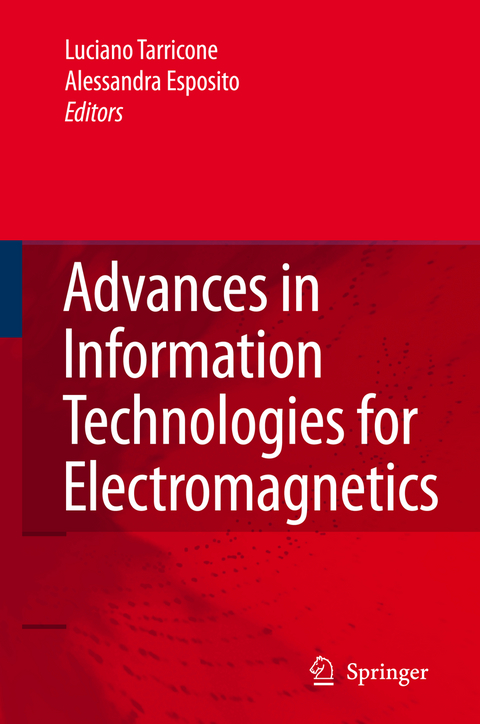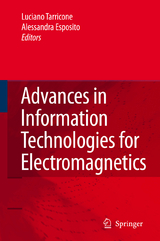Advances in Information Technologies for Electromagnetics
Springer-Verlag New York Inc.
978-1-4020-4748-0 (ISBN)
Simple tutorial chapters introduce the reader to cutting edge technologies, such as parallel and distributed computing, object-oriented technologies, grid computing, semantic grids, agent based computing and service-oriented architectures.
On such bases, a variety of EM applications is proposed: 1) parallel FDTD codes (both for antenna analysis and for metamaterial applications), 2) grid computing for computational EM (CEM) (with applications to antenna arrays, wireless and remote-sensing systems) 3) mobile agents for parametric CEM modeling 4) complex/hybrid EM software environments (with applications to planar circuits, quasi-optical systems,…) 5) semantic grids for CAE of antennas arrays.
This way the reader, after learning from very schematic tutorials the most relevant features of IT tools, has an immediate feeling of their impact on daily EM research.
Luciano Tarricone - Biography Luciano Tarricone is an Associate Professor of Electromagnetic Fields at the University of Lecce, Italy. He received his laurea degree (with honors) from the University of Rome "La Sapienza", Italy, and his PhD from the same university, both in Electronic Engineering. In 1990 he was a researcher at the Italian National Institute of Health, and between 1990 and 1994 at the IBM European Center for Scientific and Engineering Computing. Between 1994 and 2001 he was at the University of Perugia, Italy. Since 2001 he has joined the University of Lecce. His main research areas are: supercomputing for Electromagnetics, environmental electromagnetic compatibility, CAD of microwave circuits and antennas. He authored around 160 papers in international conferences and journals, and edited 3 volumes in the area of high performance computing for electromagnetics. Alessandra Esposito – Biography Alessandra Esposito is a free consultant in the area of Computer Science and Information Technologies, with a focus on networking, web and grid applications for research in universities and small, medium and large companies. She received her laurea degree (with honors) in Electronic Engineering from the University of Naples. Between 1990 and 1994 she was with IBM Scientific Center in Rome, Italy. In 1994 and 1995 she was a system engineer for Sodalia, Trento, Italy, involved in research and development in the area of distributed systems. Since 1995 she has cooperated with several research institutions, universities and business companies, in the framework of educational, research and industrial projects. She authored about 40 papers in international conferences and journals.
Chapter 1 Parallel and Distributed Environments; A.Esposito. 1. Introduction. 2. basic concepts. 3. parallel programming. 4. distributed systems. 5. The Web.
Chapter 2 Object Oriented Technologies; A.Esposito. 1. Introduction. 2. OO programming. 3.oo distributed frameworks.
Chapter 3 The Semantic Web; A.Esposito. 1. Introduction. 2. Description Logics. 3. tools for the Semantic Web.
Chapter 4 Web Services; A.Esposito. 1. Introduction. 2. basic concepts. 3. web services description: wsdl. 4. Automatic discovery of web services.
Chapter 5 Grid Computing; A.Esposito. 1. Introduction. 2. GC basic concepts. 3. the globus toolkit. 4. GT components. 5. job management. 5.1 GC for HPC. 6. information services. 7. data management.
Chapter 6 Complex Computational Electromagnetics using Hybridisation Techniques; Raed A. Abd-Alhameed and P.S.Excell. 1. Introduction. 2. Outline of theory and implementation of hybrid method. 2.1 Hybrid Treatment for Homogeneous Multiple Elements. 3. Incident Wave Excitations in the FDTD Method. 3.1Total/Scattered Field Formulation in Three Dimensions. 4. Modified Total/Scattered Field Formulation for the Hybrid Technique. 5. Validation of Total/Scattered Field Formulation Implementation using Homogeneous FDTD in Multiple Regions. 6. Hybrid MoM/FDTD Technique Algorithm. 7. NEC/FDTD Hybrid Program. 8. Far Field Calculations using the Hybrid Code. 9. Numerical Examples using the Hybrid MoM/FDTDTechnique. 10. Summary.
Chapter 7 Enhanced EM software for Planar Circuits; D. Vande Ginste, F. Olyslager, D. De Zutter, and E. Michielssen. 1. Introduction. 2. Classical solution technique for microstrip structures. 3. Perfectly matched layer based Green’sfunctions for layered media. 4. A PML-MLMFA for the modeling of large planar microstrip structures. 5. Extensions and conclusions.
Chapter 8 Parallel Grid-enabled FDTD for the Characterization of Metamaterials; L.Catarinucci, G.Monti, P.Palazzari and L.Tarricone. 1. Introduction. 2. Introduction to metamaterials. 3. Negative Refraction. 4. How to Synthesize a DNG Medium. 5. DNG Media Applications. 6. Modulated Signals in a DNG medium. 7. numerical methods for metamaterials.
Chapter 9 A Software Tool for Quasi-Optical Systems; N.C. Albertsen, P.E. Frandsen and S.B. Sørensen. 1. Introduction. 2. Requirements for Quasi-Optical Network Design. 3. Outline of the software system. 4. Analysis methods. 5. User interface - The Frame Editor. 6. Components and objects: The object wizard. 7. complex commands: The command wizard. 8. Frame connections and 3D modelling. 9. Evaluation and Future extensions.
Chapter 10 Cooperative Computer Aided Engineering of Antenna Arrays; A. Esposito, L. Tarricone, L.Vallone and M.Vallone. 1. Introduction. 2. CAE of Aperture Antenna Arrays. 3. grid services and semantic grid. 4. system architecture. 5. The framework. 6. conclusions.
Chapter 11 Distributed and Object Oriented Computational Electromagnetics on the grid; D.Caromel, F.Huet, S.Lanteri and N.Parlavantzas. 1. Introduction. 2. Distributed Objects: Proactive. 3. OO distributed finite volume solver. 4. Benchmarks. 5. on-going and Future Work. 6. Conclusions.
Chapter 12 Software Agents for Parametric Computational Electromagnetics Applications; D. G. Lymperopoulos, I. E. Foukarakis, A. I. Kostaridis, C. G. Biniaris,D. I. Kaklamani. 1. Introduction. 2. Classification of Parametric Problems in CEM. 3. Mobile Software Agents. 4. A Web-based Mobile Agent Platform forParametric CEM Modeling. 5. Introducing Genetic Software Agents.
Chapter 13 Web Services Enhanced Platform for Distributed Signal Processing in Electromagnetics; I. E. Foukarakis, D. B. Logothetis, A. I. Kostaridis,D. G. Lymperopoulos, D. I. Kaklamani. 1. Introduction. 2. Web Services in Distributed SAR Modelling and Signal Processing.
Chapter 14 Grid-Enabled Transmission Line Matrix Modelling of Electromagnetic Structures; P. Russer, B. Biscontini and P. Lorenz. 1. Introduction. 2. The 3D-TLM Method. 3. Modelling of Dielectric Media. 4. Parallelization of the TLM Method. 5. TLM-G: Grid-enabled Time Domain Transmission Line Matrix System. 6. Analysis of the Performance of the TLM-G System and Examples. 7. The Circular Cylindrical Cavity Resonator
| Zusatzinfo | XXVII, 458 p. |
|---|---|
| Verlagsort | New York, NY |
| Sprache | englisch |
| Maße | 155 x 235 mm |
| Themenwelt | Technik ► Elektrotechnik / Energietechnik |
| ISBN-10 | 1-4020-4748-7 / 1402047487 |
| ISBN-13 | 978-1-4020-4748-0 / 9781402047480 |
| Zustand | Neuware |
| Haben Sie eine Frage zum Produkt? |
aus dem Bereich




